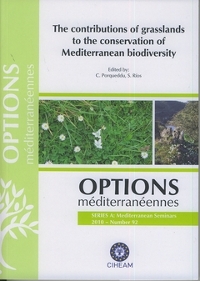| Article précédent | p. 271-275 | Article suivant |
Assessment of plant covers with native legumes in Mediterranean semi-arid woody crops
The aim of this work is to present the design of handling methods carried out with plant covers over a period of 12 consecutive years in an olive and vineyard grove on the experimental plantation La Higueruela (Toledo, Spain). Starting from the initial working hypotheses, connected with minimising the soil erosion which had been produced by the conventional management of these woody crops for more than 50 years, the benefits of plant biodiversity (weed vegetation) and covers with subterranean clover, have been considered and the question of how to manage permanent covers. Ecological cover use may be systematised under the headings which encompass the main results obtained: (i) environmental services of permanent plant covers; (ii) use of main functional groups of the communities proceeding from the soil seed bank; (iii) sustainable management of N and C in the very olive grove system; and (iv) minimisation of competition for water by paying attention to the evaluation of autochthonous leguminous crops adapted to the constant fluctuations of a Mediterranean climate. Although previous works have set out results from this research, we now offer an evaluation from what might be regarded as the perspective of ecological engineering.
L'objectif de ce travail est de présenter la conception de méthodes de gestion réalisées sur la couverture végétale pendant douze ans consécutifs dans une oliveraie et un vignoble sur la plantation expérimentale de La Higueruela (Tolède, Espagne). À partir de l'hypothèse de travail initiale basée sur la réduction de l'érosion des sols causée par la gestion traditionnelle de ces cultures ligneuses pendant plus de cinquante ans, les profils de la biodiversité végétale (la végétation adventice) et de la couverture de trèfle souterrain ont été envisagés ainsi que la question de savoir comment gérer la couverture végétale permanente. L'utilisation de la couverture écologique peut être systématisée dans les rubriques comprenant les résultats principaux obtenus : (i) les services environnementaux des couvertures permanentes ; (ii) l'utilisation des principaux groupes fonctionnels de communautés en provenance du stock semencier du sol ; (iii) la gestion durable du N et C dans chaque système d'oliveraie ; et (iv) la réduction de la concurrence pour l'eau, en faisant attention à l'évaluation des cultures de légumineuses autochtones adaptées aux fluctuations constantes du climat méditerranéen. Bien que les travaux précédents aient décrit les résultats de cette recherche, nous proposons maintenant une évaluation de ce qui pourrait être considéré comme un point de vue de l'ingénierie écologique.
- [ Afficher ]
- [ Télécharger ]
- [ Exporter la citation ]
Vous pouvez télécharger la citation au format :
- [ Imprimer ]
-
Mots-clés
COUVERTURE VEGETALE, LEGUMINEUSE, PLANTE LIGNEUSE, VARIETE INDIGENECiter cet article
Hernández A.J., Ramos-Font M.E., Pastor J. Assessment of plant covers with native legumes in Mediterranean semi-arid woody crops. In : Porqueddu C. (ed.), Ríos S. (ed.). The contributions of grasslands to the conservation of Mediterranean biodiversity. Zaragoza : CIHEAM / CIBIO / FAO / SEEP, 2010. p. 271-275. (Options Méditerranéennes : Série A. Séminaires Méditerranéens; n. 92). 13. Meeting of the Sub-Network on Mediterranean Forage Resources of the FAO-CIHEAM International Network for the Research and Development of Pasture and Forage Crops, 2010/04/07-10, Alicante (Spain). http://om.ciheam.org/om/pdf/a92/00801255.pdf



